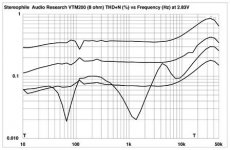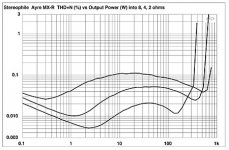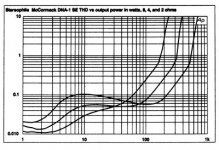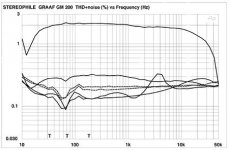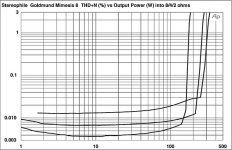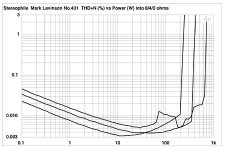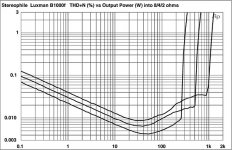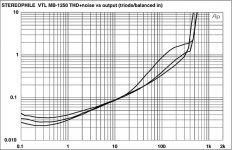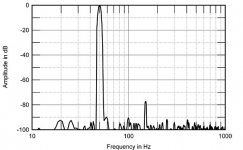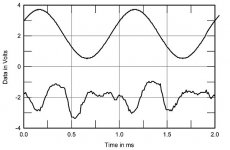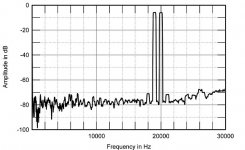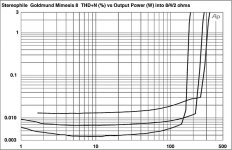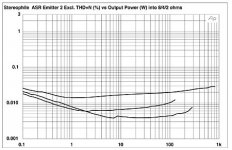Distortion spectra, which starts out low , in the miliwatt range and then go high as power increases seems to fair better than those which starts out high then lowers as power is increased, in subjective listening test ..
I had touched on this many moons back any additional thoughts ... ?
That needs saying . One of my recent amps is very low distortion below 1 watt and 10 % where there is still useful power . Correcting the 10 % has lost some of the magic . Unlike most people I don't tell myself I prefer that type of distortion as with great experience I can say absolutely not so . Where it gets interesting is to say correcting it spoils that amplifier . The amplifier which I like equally has so close to zero distortion as to be almost a high grade op amp . Both allow me to be lost in the music . Both annoy me when loud . The 10% one as it becomes obvious we have rejoined the 1950's the other for it's lack of camouflage . Up to 5 watts it is hard to say one is better than the other .
I said the other day I was almost tearful at the simplicity of the mathematical description of feedback . Having seen those patterns many times it is helpful to say it is that simple . For example I was told the best description of a suspension bridge shape is a catenary . My friend said no because the chain suspends a load ( the bridge , a parabola ) . Galileo apparently got it wrong when mistaking a catenary for a parabola . These " shapes " are important .
To say negative feedback is the same as local feedback is in the simplest sense correct . If I degenerate an amp using global feedback with a little bit of local feedback it is not obvious anything has changed . The amplifier has to be reduced to a state of obvious dysfunction to yield trends . This tells me two things . First it is a good amplifier and secondly global is probably the optimum feedback for that amplifier . Another amp might show nasty harmonics using global that the local feedback does not . That amp is the " Chaotic pendulum " . Now just as a chaotic pendulum is a fake ( I feel it is although understand how that might not be true ) the feedback amp is not chaotic . Understanding it might be close to understanding chaos . By that I would refer back to Michael Gerzon and filters . It is worth saying the global amp when far from dysfunction does not sound exactly the same when trading local feedback . It looks so similar on an analyses as to be an identical twin . Having known identical twin girls they are not the same . I choose the wrong one I can tell you .
It is said in engineering that which is impossible should be made irrelevant . I wondered would it be better to make a power amplifier into an active filter ? I have done this at lower frequency for re-generators using Chebishev curves . The formulea are well known and simple to apply . Bessel ,Butterworth , Gaussian ,Linear phase , you name it . Here is the conjecture ( informed guess as Michael says ) . Apply a filter curve of sensible generosity of bandwidth to an amp . Does it sound better or worse than usual . This amp will have to be very fast to be useful . I suspect many of us have unwittingly have been doing this for years now ? Doubtless someone will tell us this is obvious or well known . Perhaps . I don't remember it said this way ? Instinctively I feel this to be a very bad idea . However .....?
Many shapes I see in everyday life I understand without resorting to reminding myself of the mathematical formula . The cone , cylinder , parabola . I passed my job interview by reciting Papas Guildinus theorem ( no big deal ) . The boss to be got me drunk at the interview then asked that . One could say geometrical maths is never boring to me . My mentor says we lost something when science was removed from the "Arts " . He makes a nice income from being an opera singer . His PHD is in electrical engineering .
Last edited:
But did you label the knob "distortion" or "musicality"?Wavebourn said:I even designed a "harmonizer" with a knob to add tube distortions, but nobody likes it.
Courtesy of STphile , a few contenders ....
Attachments
The Goldmund is so surprising as it is a very simple circuit ( an assumption as I may not know this specific circuit ) . I know those curves from others which are generically similar ( even the HH 1200 ) . Even people who work in PA wouldn't think of HH as anything special . I wonder with better speakers if it would shine ? I have never measured one so can only say is starts with what should get it there as a circuit
Last edited:
Contenders for what?
MIcro watt -1 watt THD ...
MIcro watt -1 watt THD ...
Not enough... More critical, what kind of HD, and how spectrum changes with power. Also, some other illnesses play the role. Like IMD between high frequencies with their difference below 20 Hz can show other symptoms of common modern amps with astonishingly low THD.
Average temperature between patients in the clinic tells nothing about their health states.
Last edited:
I can provide, too much to list for all of them , pick an eg from the list ....I like the Goldmund .
Not enough to judge. But some aspects, yes. Gooldmud and VTL both can be better than the rest pf amps. But can be worse. An amp with 140 dB open loop gain at 10 Hz can demonstrate nice THD/Power curves, but sound dirty.
Last edited:
OK, I will post spectra for VTL and goldmund for comparison ...good choices SS vs Tooobie !!
I did not choose. I said that it is not enough to judge.
Relax I'm going to get you all the data you could ever use ... 
Goldmund ...
Fig.1 Goldmund Mimesis 8, spectrum of 50Hz sinewave, DC–1kHz, at 72W into 4 ohms.
Fig.2 Goldmund Mimesis 8, 1kHz waveform at 100W into 8 ohms (top); distortion and noise waveform with fundamental notched out (bottom, not to scale), 0.007%.
Fig.3 Goldmund Mimesis 8, HF intermodulation spectrum, DC–22kHz, 19+20kHz at 20V p–p into 4 ohms (linear frequency scale).
Fig.4 Goldmund Mimesis 8, distortion vs output power into (from bottom to top at 10W): 8 ohms, 4 ohms, and 2 ohms.
Goldmund ...
Fig.1 Goldmund Mimesis 8, spectrum of 50Hz sinewave, DC–1kHz, at 72W into 4 ohms.
Fig.2 Goldmund Mimesis 8, 1kHz waveform at 100W into 8 ohms (top); distortion and noise waveform with fundamental notched out (bottom, not to scale), 0.007%.
Fig.3 Goldmund Mimesis 8, HF intermodulation spectrum, DC–22kHz, 19+20kHz at 20V p–p into 4 ohms (linear frequency scale).
Fig.4 Goldmund Mimesis 8, distortion vs output power into (from bottom to top at 10W): 8 ohms, 4 ohms, and 2 ohms.
Attachments
Last edited:
OK, I will post spectra for VTL and goldmund for comparison ...good choices SS vs Tooobie !!
What ever happened to VTL? They were big for a while. Not as "tube" as CJ at the time.
I remember when Klipsh was still with us saying "what the world needs is a good 10W amp", so David built one. The K-horn still sounded like a K-horn. Oh well.
Relax I'm going to get you all the data you could ever use ...
Goldmund ...
Fig.1 Goldmund Mimesis 8, spectrum of 50Hz sinewave, DC–1kHz, at 72W into 4 ohms.
Fig.2 Goldmund Mimesis 8, 1kHz waveform at 100W into 8 ohms (top); distortion and noise waveform with fundamental notched out (bottom, not to scale), 0.007%.
Fig.3 Goldmund Mimesis 8, HF intermodulation spectrum, DC–22kHz, 19+20kHz at 20V p–p into 4 ohms (linear frequency scale).
Fig.4 Goldmund Mimesis 8, distortion vs output power into (from bottom to top at 10W): 8 ohms, 4 ohms, and 2 ohms.
That fig 3 is misleading as the difference freq falls exactly on the Y-axis line and cannot be seen clearly. It LOOKS like -45dB but that's just eyeballing it.
jan didden
What ever happened to VTL? They were big for a while. Not as "tube" as CJ at the time.
I remember when Klipsh was still with us saying "what the world needs is a good 10W amp", so David built one. The K-horn still sounded like a K-horn. Oh well.
VTL is still around , i saw Luke Manley last year and he is stil at it... !!!
That fig 3 is misleading as the difference freq falls exactly on the Y-axis line and cannot be seen clearly. It LOOKS like -45dB but that's just eyeballing it.
jan didden
That's all I got , next up VTL .....
Recently I have been experimenting with various class A amplifiers to see where they are similar and where they differ . The similarities are greater than they should be as tube versions are very different in how feedback can be used . I conclude that whilst satisfactory for general enjoyment digital sources are not good enough to truly hear what I measure . Vinyl seems a crazy better source . Ideally the last part of my quest would be a magnetic amplifier . On paper it could be a winner . The problem is I will end up listening to it's above one watt performance mostly where it will be the least good if respecting how we understand measurements . I am probably wrong about this . Instinct says I am not . I was expecting better linearity below one watt would make up for lost information , seemingly not . As DVV said what should we expect from 4 bits as it often is ? In the ideal world everything would be recorded on an advanced analogue system which can be reformatted in digital for connivance . To make it attractive it would have to be easier to use than digital which was often true in the past . 100 db dynamic range 1 Hz to 40 kHz - 1 dB or better . Distortion 1 % at + 10 dB with 20 dB absolute headroom . Perhaps if we bought a CD we might pay $50 to have it analogue for special things . I have no idea how it stored as analogue .
The trouble is, there seems to be no ground zero point except for our own ears - and that's one hell of a "zero point".
Take digital recorded material. Sometimes we blame the software (CD, LP) without even realizing that it0's actually our hardware which is to be balmed, not the software. Take the same disc and replay it elsewhere and it may well provide a far better signal than we even hoped for. Quite simply, one CD player may appear to be inferior to another on typical music progarmme, but on occasion, it can outplay the nominally better one with some recordings.
I still think the most lifelike form of recording is a high speed tape recording bar none. The quality and sheer quantity of musical detail surpasses anything and everything else.
In case od CDs, it's as if we benefit from sort of slowing it down from typical digital conversion via a tape to listening level. I often wonder why so many CDs sound better when first recorded on analog tape and then played back. A very odd situation.
This is further reinforced by the simple fact that my Aussie real time DAC, using 8 parallel Philips DACs (1543), usually sound the pants off much more expensive and exalted devices, when this should not happen in theory. While the 1543 DAC is hardly known as one of Philips' best, it does have one trait which sets it apart - its supply voltage is about 2 V above most others, thus giving it a little extra headroom. Not to even mention the much simpler signal path.
Take digital recorded material. Sometimes we blame the software (CD, LP) without even realizing that it0's actually our hardware which is to be balmed, not the software. Take the same disc and replay it elsewhere and it may well provide a far better signal than we even hoped for. Quite simply, one CD player may appear to be inferior to another on typical music progarmme, but on occasion, it can outplay the nominally better one with some recordings.
I still think the most lifelike form of recording is a high speed tape recording bar none. The quality and sheer quantity of musical detail surpasses anything and everything else.
In case od CDs, it's as if we benefit from sort of slowing it down from typical digital conversion via a tape to listening level. I often wonder why so many CDs sound better when first recorded on analog tape and then played back. A very odd situation.
This is further reinforced by the simple fact that my Aussie real time DAC, using 8 parallel Philips DACs (1543), usually sound the pants off much more expensive and exalted devices, when this should not happen in theory. While the 1543 DAC is hardly known as one of Philips' best, it does have one trait which sets it apart - its supply voltage is about 2 V above most others, thus giving it a little extra headroom. Not to even mention the much simpler signal path.
- Status
- Not open for further replies.
- Home
- Member Areas
- The Lounge
- Sound Quality Vs. Measurements
